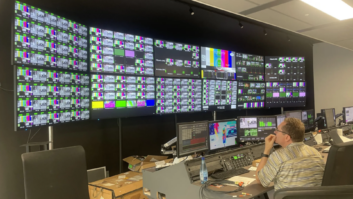Is the cloud still a disruptor in the media industry? Or has it moved into the mainstream?
And how important will it be in 2024 with some major sporting events in the calendar?
TVBEurope hears from key industry experts about their predictions for the cloud over the next 12 months.
Gabriel Kerner, CEO, Alvalinks
The integration of cloud into operations, workflows, video streams and streaming services is something we are already seeing everywhere – however, it’s the aspect of live streaming by broadcasters and the gigantic impact of remote contribution to the cloud, that I think will see the most development in 2024. With large audiences possibly becoming live video contributors, broadcasters need to ensure they can manage multiple simultaneous remote streams and distribute them adequately. This needs a rethink, not only on the infrastructure, but also on how it is managed and orchestrated, to ensure customer experience can leverage these new models.
The addition of automation, orchestration and observability toolsets within the broadcast and media industry is something I am hoping to see. The involvement of the nascent concepts present in the business models proposed for broadcasting in the streaming market will be heavily built on in 2024. The existence of these concepts has again proven the need to embrace the internet and cloud as core technological tenants, and in doing so, must be supported by automation to some degree.
Kristian Mets, head of sales business development, Net Insight
In 2024, we anticipate the continued expansion of cloud-based solutions, especially in high-end production. We’re looking at the prospect of large data centres being interconnected via high-capacity links, effectively erasing geographical boundaries between production venues and resources. This will facilitate true distributed production, even for high-end events, setting a new standard for the industry.

We also foresee the emergence of intelligent AI applications in professional event productions. This could manifest in areas such as automatic camera control and audio mixing. These innovations have the potential to revolutionise the way we approach content creation and enhance the overall quality of productions.
Jean-Christophe Perier, CMO, Globecast
Moving to the cloud is a key way of addressing the cost of both technology and overall infrastructure. It means moving from a capex to an opex model, which is clearly advantageous, and also provides the ability to scale services far more quickly and accurately. The overall level of flexibility provided by the cloud cannot be ignored. This is where we see consulting services, which we are offering, as being very important to help customers understand what a move to the cloud entails and how it can be achieved on a case-by-case basis. Of course, a major focus is on cost control. Moving to the cloud will accelerate with experts like Globecast helping drive this.
Stéphane Guez, co-founder and principal, Dalet
Cloud production is not a new trend, but the continuation of a profound movement. As media consumption is steadily moving from linear television to digital platforms, so is media production moving to the cloud. The scope of what it can do (remote production, virtual studios, live events) is expanding. It has enormous benefits, and the ease of access may open new opportunities for small production ventures. But it also has challenges around technology maturity, security, redundancy or disaster recovery, content and application migration, and more generally costs – especially with solutions that are not yet completely optimized to take full advantage of the elasticity and agility of cloud infrastructure.
Cloud production will certainly expand further as all media operations continue to move to the cloud. Moving more live production – including sports – to the cloud will further dent the relevance of linear television. Could unpredictable costs and the business dependency on cloud providers slow down or interfere with that process? Probably not the development of new technology and applications, but maybe the way it is deployed. This is more important for the media industry, which is a big consumer of storage, bandwidth and CPU – a dream for cloud providers.

Cameron Smith, CTO, Dejero
The adoption of cloud-based workflows, especially for live content has been slow because of connectivity concerns – up until now.
When it comes to cloud technology, it ultimately provides a scalable, flexible infrastructure achievable without large capital investment. In the cloud, additional content can easily be distributed across additional channels. New revenue opportunities can be created in a more flexible infrastructure: the cloud is managed for you and is available whenever you need it. It is allowing smaller players and new entrants to the market to grow quickly, without having the baggage of the big broadcasters. Taking away the need for capital investment and moving to an operational model, spinning up and shutting down processes as needed, the cloud will enable any outfit to run an enterprise-grade media operation. They will drive revenue much quicker, from a significantly lower cost base.
But connectivity is required for the cloud to be successful.







